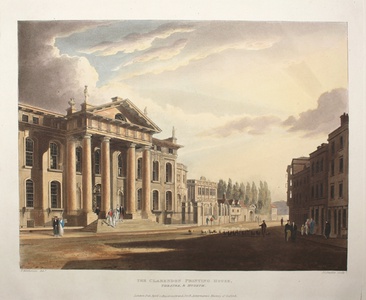| Method | Aquatint with hand colouring |
| Artist | Joseph Constantine Stadler after Frederick Mackenzie |
| Published | London, Pub. April 1. 1814, at 101 Strand for R. Ackermann's History of Oxford |
| Dimensions | Image 284 x 209 mm, Plate 250 x 295 mm, Sheet 289 x 354 mm |
| Notes |
A view of the Clarendon Printing House, from Rudolph Ackermann's A History of the University of Oxford, its Colleges, Halls and Public Buildings. Rudolph Ackermann (1764 - 1834) was a lithographer and publisher born in Saxony. He moved to London in 1787 and later established a business as a coachmaker at 7 Little Russell Street, Covent Garden. In 1796, having already published the first of many books of carriage designs, he moved to 96 Strand where he ran a drawing school for ten years. The following year, Ackermann moved to 101 Strand (known, from 1798, as The Repository of Arts) where he sold old master paintings and artists' supplies as well as prints. In 1803, 220 Strand was given as his address in a print published that year. The Microcosm of London (1808-10) and the monthly Repository of Arts (1809-29) established his reputation for fine colour plate books. From 1816, he began to publish lithographs. Ackermann always maintained links with his native Germany, and in the 1820s, he also opened outlets in Mexico, Guatemala, Colombia, Argentina, and Peru. In 1832, he handed the running of the business over to his second son George and his younger brothers, who traded as Ackermann & Co.at 106 The Strand until 1861. Ackermann also established a print business for his eldest son Rudolph at 191 Regent Street. Joseph Constantine Stadler (1780-1822) was a German painter and aquatint engraver. He began working in London in the 1780s with ambitious topographical works. He worked on various publications with artists such as Joseph Farington, who made the drawings for 'An History of the River Thames' by William Combe (1794-6), Robert Bowyer with Philippe Jacques de Loutherbourg's 'Picturesque Scenery of Great Britain' (1801) and on many publications for Rudolph Ackermann, including 'Views of London' (1812-22) and 'Public Schools' (1816). In 1787 he exhibited four landscapes at the Royal Academy in London, and in 1822 he engraved the 18 plates for Thomas Rowlandson's 'Sketches from Nature' (1822). Frederick Mackenzie (1787-1854) was a British watercolour painter and architectural draughtsman who made drawings for Ackermann's University of Oxford and Public Schools, and twenty-four of the Oxford Almanacks between 1821 and 1853. |
| Framing | mounted |
| Price | £225.00 |
| Stock ID | 49248 |

